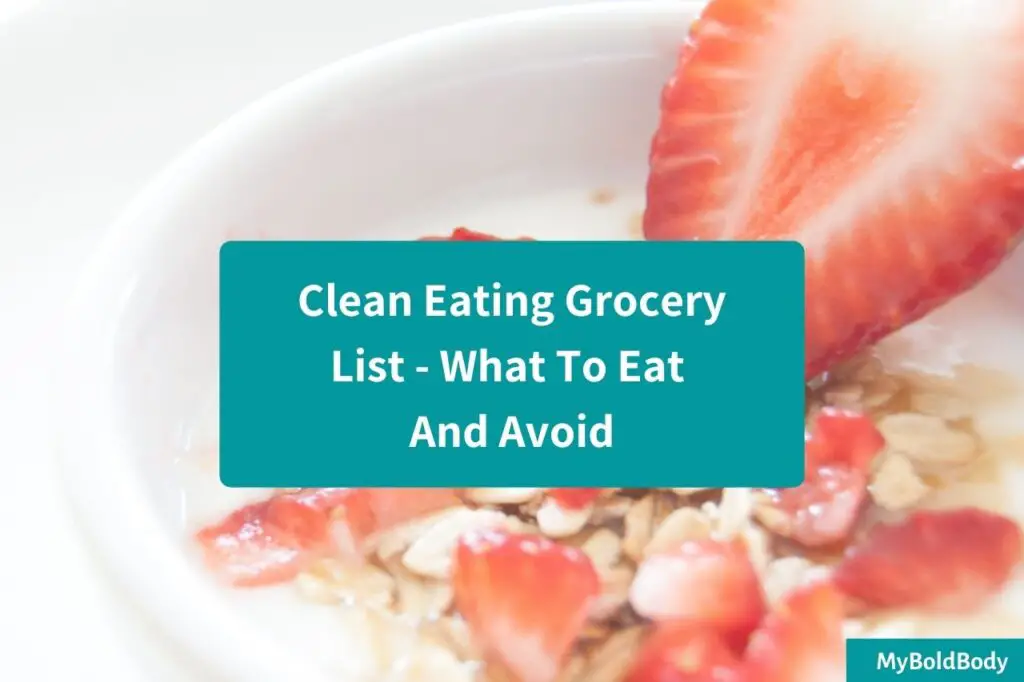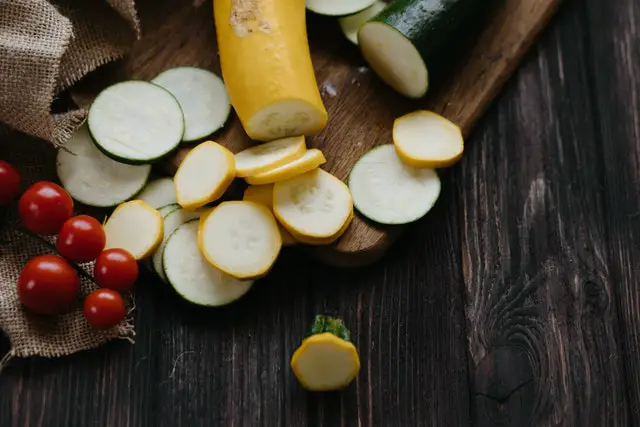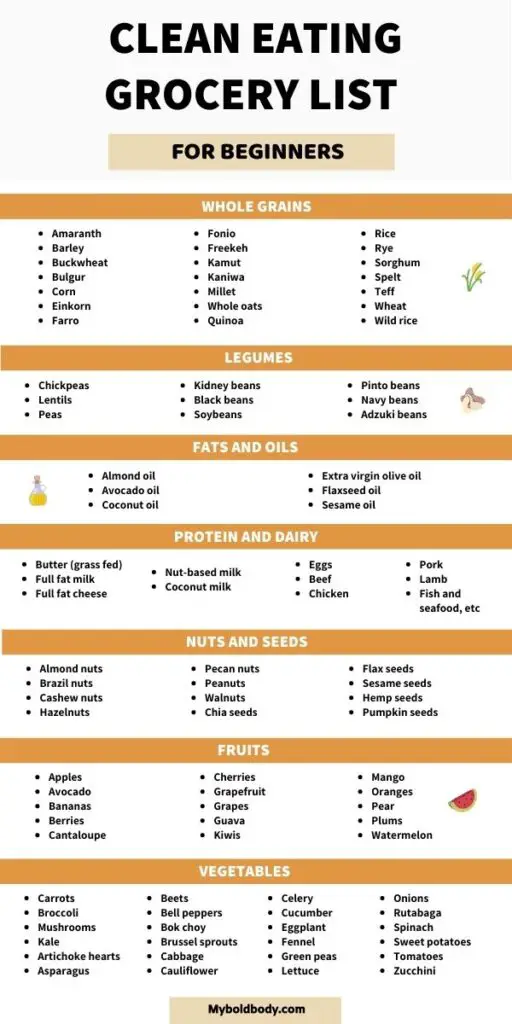This post may contain affiliate links. For more info, please read our full disclosure here

When it comes to living a healthy lifestyle, we can all agree that the kinds of food we eat play a really big part in that.
And by making better food choices, we can greatly improve our overall well-being, both physically and in other aspects as well.
One of the popular approaches today, to improving health though better food choices, is clean eating. Put simply, it’s an eating style that focuses more on rich whole foods, and less on processed ones.
While that’s the basic idea, you may still be wondering how it all works, how to do it, as well as the best kinds of foods to eat.
In this article, you’ll learn what clean eating is, how it works, potential benefits, as well as the best, and also worst foods to eat, plus some helpful tips to help you out along the way.
Plus at the end, there’s a simple clean eating grocery list printable to help you out on your next shopping trip.
Let’s dive in.
Clean Eating – What Is It?

Clean eating focuses on the consumption of rich whole foods, occurring in their natural state, and aims to greatly minimize, if not completely avoid the consumption of foods that are packaged or processed.
The concept of clean eating is pretty simple.
Every day, we eat food (obviously). Some of these food items, especially the ones that have gone through some form of heavy processing or alteration, may sometimes contain not-so-good ingredients, which may cause certain problems for our body.
These problems can range from increased cholesterol, a higher risk of diabetes, obesity and so on.
So by greatly reducing or eliminating these types of foods from our diet, and focusing on healthy whole foods, we can help avoid these issues, and enjoy the benefits of a healthy body.
Eating cleaner does seem to have its perks though. Here are some benefits associated with clean eating.
Also See: Complete Beginner’s Guide To The Keto Diet
Benefits Of Clean Eating
Weight Loss
The promise of weight loss is one that usually leaves a lot ears standing. And although there are a lot of factors that go into losing weight, eating cleaner can actually help.
For example, a lot of highly processed foods are loaded with extra calories, added sugar and even trans fats. All of which can lead to weight gain.
On the other hand, their non-processed counterparts seem to be lower in calories, and much higher in nutrients compared to them.
For this reason, adopting a cleaner approach to eating can help you consume less calories overall, and potentially support weight loss.
Improved Heart Health
Adopting a cleaner approach to eating, fills your plate with lots of heart healthy fruits and veggies, which are low in saturated and trans fats, and high in good nutrients that support cardiovascular health.
Highly processed foods on the other hand, seem to be nearly the opposite, since a lot of them are high in saturated and trans fats, which have been shown to raise cholesterol, as well as the risk of heart disease when consumed in large amounts.
Better Energy Levels
No one likes feeling drowsy or slow in the middle of the day, and eating healthier can actually help.
Apart from being nutrient dense, lots of whole grains and veggies are high in fiber, which support a healthy digestion, gradual release of energy, and lower blood sugar levels.
On the other hand, things like sodas, packaged fruit juices, or other food items high in added sugar, have a high glycemic index and can contribute to a rapid rise and fall in blood sugar levels, which usually leaves you feeling terrible.
Other benefits associated with clean eating include
- Lower risk of certain cancers,
- Improved brain health,
- Longevity, and more
So then, what foods can be considered “clean” and what foods should be best minimized or eliminated.
Also See: 30 Delicious Mediterranean Diet Recipes For Weight Loss
What To Eat (And Avoid)

Whole grains
Grains, especially whole grains, are without a doubt, a wonderful addition to our diets. Even though most of them tend to have a high carb content, they’re usually rich in fiber too, which encourages much better digestion, and gradual release of energy.
They’re also a good source of minerals and nutrients. Whole grains are generally more nutritious than their processed counterparts, as some important nutrients may be lost during processing.
Some very popular whole grains include;
- Brown rice
- Quinoa
- Oatmeal
- Barley
- Whole wheat
- Whole grain rye
- Millet
Legumes
Legumes are well known for being a good source of plant-based protein, and they are actually used as great meat-substitutes by people on vegetarian or vegan diets.
As you can guess, they’re also rich in nutrients, and pack a good fiber punch as well. Some of the best legumes include;
- Peas
- Lentils
- Different sorts of beans, like black beans, kidney beans, navy beans, soybeans etc.
- Chickpeas
Canned beans are super convenient to use, but usually raise the question of being healthy, considering the liquid used in them tends to be high in sodium.
If this bothers you, a good solution could be to rinse out the liquid, and use the beans plainly. Your meals will still come out every bit as yummy.
Also See: Complete Keto Diet Food List For Beginners
Fats and oils
After years of being blamed for making people, well, “fat”, fats have finally entered the spotlight as being good for us, when consumed right.
Diets like keto that emphasize a high fat, low carb consumption have been shown to have numerous benefits, like weight loss, better blood sugar levels, improved metal performance and more.
It is worth noting though, that not all fats are created equal. Foods high in unsaturated fats can be good for you, while foods high in saturated or trans-fats might not be the best option.
Same thing goes for oils. Highly processed oils are not that good for you. Other types of oils such as olive oil, coconut oil and avocado oil are usually recommended.
Meats and dairy
These can act as a great source of animal-based protein, as well as healthy fats in some cases. Just like the previous ones, you’ll generally want to steer clear of processed meats. Grass-fed options tend to work best in cases like this.
Same thing goes for dairy products like yoghurt, cheese and milk. Minimally processed options are always best.
Nuts and seeds
Nuts and seeds are nutritional powerhouses. Despite their tiny size, they’re incredibly nutritious, and tend to be rich in protein, fiber and healthy fats.
For example, chia seeds, besides being quite filling and super nutritious, are rich in omega-3 fatty acids, which can help lower cholesterol and reduce the risk of cardiovascular diseases.
Similar nuts and seeds also deliver interesting health benefits as well, and definitely have a place in a healthy clean eating diet.
Fruits
There’s hardly any reason to not want to include fruits in your clean eating diet. First of all, they’re naturally sweet, plus they have a decent nutritional profile, packed with important vitamins, minerals and nutrients.
As a general rule of thumb, fresh is always better. You can still enjoy some frozen or canned fruits as well. Just be sure to check the ingredient list for funny-looking additives.
Vegetables
You simply can’t go wrong with veggies. They are one of the best things you can add to your diet. Nutrient rich, and quite satisfying too.
When it comes to clean eating, just like in the case of fruits, fresh is best. But frozen veggies are also a great option too, and can be enjoyed as well.
Extra Clean Eating Tips For Success
Here are some more tips that’ll help you make your clean eating journey way easier.
1) Don’t Forget To Meal Prep
With processed and packaged food out of the options, odds are you’ll need to prepare most, if not all of your meals. And considering how busy our schedules are these days, it can seem somewhat like a task.
With meal prepping, you can easily make your meals ahead of time, and simply grab, reheat, and enjoy. Not only is it a good way to save some time during those busy weeks, but it can also help you save some extra money too, and better keep track of your meals.
Don’t worry, it’s pretty simple and easy to do. Check out this complete beginner’s guide to meal prepping, to help you with everything you need to get started.
Also See: Meal Prepping 101: How To Meal Prep For Beginners
2) Take A Peek At The Ingredient List
Not all products labelled as “healthy” or “light” will actually be clean eating friendly. A good way to navigate this is to always take a peek at the ingredient list in the labels.
Basically you want to be watching out for things with large amount of added sugars, artificial additives and other unhealthy ingredients.
3) Make Cleaner Substitutes
Cravings will hit. That’s one thing for sure. Rather than giving into the temptation of jumping ship and throwing your clean eating lifestyle out the window, a good alternative is making cleaner substitutes to your favorite foods.
For example, regular pasta can be replaced with whole wheat pasta or zucchini noodles, and regular white flour can be replaced with the likes of coconut flour, almond flour or whole wheat flour.
Making cleaner substitutes can help you enjoy your favorite foods in a healthier way, and without feeling like you’re missing out on anything.
4) Pay Attention To Your Macros
Regardless of your dietary preferences, getting enough of your daily recommended macros is important.
Whether you’re trying to lose weight, build muscle, or just keep fit and eat healthier, knowing and sticking to your recommended macro ratios is a key to success.
If you’re not sure what your recommended macro ratios are, here’s a free macronutrient calculator to help you out.
Clean Eating Grocery List Printable
Here’s a simple clean eating printable to help you out on your next trip to the grocery store.
